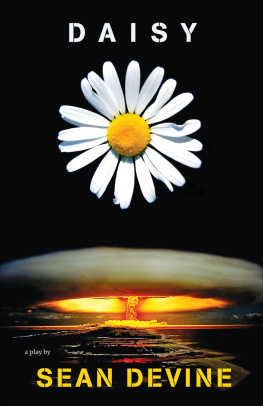Contents
Page List
Landmarks
Also by Sean Devine
Re:Union (2013)DAISY
a play by SEAN DEVINE Talonbooks
2017 Sean Devine Foreword 2017 Joe Slade White Introduction 2017 Warren Kinsella All rights reserved. No part of this book may be reproduced, stored in a retrieval system, or transmitted, in any form or by any means, without the prior written consent of the publisher or a licence from Access Copyright (The Canadian Copyright Licensing Agency). For a copyright licence, visit www.accesscopyright.ca or call toll free to 1-800-893-5777. Talonbooks 278 East First Avenue, Vancouver, British Columbia, Canada V5T 1A6 www.talonbooks.com Cover and interior design by Typesmith Cover image
French Nuclear Test Licorne courtesy Alamy Stock Photo Cover image
Daisy by Jay Erickson via Flickr (CC by 2.0) Interior
Daisy ad images courtesy of the Library of Congress Talonbooks acknowledges the financial support of the Canada Council for the Arts, the Government of Canada through the Canada Book Fund, and the Province of British Columbia through the British Columbia Arts Council and the Book Publishing Tax Credit.
Rights to produce
Daisy, in whole or in part, in any medium by any group, amateur or professional, are retained by the author. Interested persons are requested to contact Catherine Mensour at Mensour Agency, 41 Springfield Road, Ottawa, Ontario, Canada K1M 1C8; TELEPHONE: 613-241-1677; EMAIL: LIBRARY AND ARCHIVES CANADA CATALOGUING IN PUBLICATION Devine, Sean, 1970, author Daisy / a play by Sean Devine ; foreword by Joe Slade White ; introduction by Warren Kinsella.
ISBN 978-1-77201-185-2 (SOFTCOVER) | ISBN 978-1-77201-413-6 (EBOOK) I. White, Joe Slade, writer of foreword II. Kinsella, Warren, 1960, writer of introduction III. Title.
| PS8607.E9454D35 2017 | C812.6 | C2017-906002-3 |
For Alexa Advertising is tax deductible.
So we all pay for the privilege of
being manipulated and controlled. Noam Chomsky
Foreword
Sean Devine has written a powerful play about a remarkable moment in history a moment so decisive that one 60-second television commercial could determine the direction of a country.
To this day, that commercial, the Daisy spot, is studied, argued over, and talked about 53 years after it aired just once. The play is Daisy. One of the plays central characters is a man named Tony Schwartz. I knew the real Tony. Tony Schwartz was a genius. And yes, that word gets thrown around a lot.
As the joke goes, If your hairdresser is a genius, where does that leave Mozart? But Tony was a genius. There was always a sense, when you were with him, of the questions and theories that were swirling around in his mind. It felt as if some floodgate was barely holding back the ideas and puzzles that delighted him. And they would spill out with wonderful energy. Tony was human. He could be irascible.
He could be impatient with those who refused to listen or who didnt want to understand. He was turning communications theory upside down. And there were a lot of people who didnt like that. But Tony was also as gentle a soul as anyone Ive ever met. Tony was agoraphobic. As far as Tony was concerned, in a perfect world, he would never have stepped outside his house or, at the very least, left the familiarity of his own New York City neighbourhood.
Anywhere beyond that, there were dragons. He would walk. He literally invented the portable tape recorder so he could walk through his neighbourhood, recording all of its sounds its reality and his. I had bragging rights to say Id actually walked down a city street with Tony. We left his house and walked two blocks. And then we walked back.
I can remember every step. And Tony would have too. He was listening. He was always listening. I remember Tony once admonished me for believing the rumour that he had never left Manhattan. I left once, he said to me.
Then he added, I wont do that again. And Im pretty sure he didnt. In 1964, the team from Doyle Dane Bernbach (DDB), which was in charge of advertising for President Lyndon Johnsons election campaign, came to Tonys home and studio in Hells Kitchen. They were seeking Tonys help. Some didnt think they needed it. Tony gave them a brilliant idea and a road map to create what is now considered the most powerful political ad ever made.
There have always been differences over who did what to produce that ad. But if anyone could do a DNA test on the Daisy ad, Tony Schwartzs DNA is all over it. The use of a childs voice; the innocent and hesitant count of the daisy petals, turning into the ominous male voices countdown, and most of all, the use of Tonys unique resonance theory. The Daisy ad played just one time, yet its effect on the Barry Goldwater campaign was devastating. It touched a true chord in the American public that was already there. It elicited a response against Goldwaters admitted potential use of nuclear weapons in the Vietnam War, without needing to mention Goldwaters name.
Tonys resonance theory held that the message of any commercial is created by the audience, not the commercial itself. In the Daisy commercial, presidential candidate Barry Goldwater is never mentioned. Tony told me that if Goldwaters name been spoken the spot would have not worked. Instead, Tony understood the audience would create the message themselves and fill in the name. In his play Daisy, Sean Devine has pulled off something that seems effortless, but in fact is extremely rare and hard to do. Devine has written characters that actually existed in history.
Thats never easy, and hard to do well. Yet these characters come to life, ring true, and make us want to hear more. Its history. We know how it all turns out. Yet this playwright makes us want to find out how it all turns out. Thats a bit of magic.
And why we go to the theatre. And why we read plays. Each time I read the play and come across one of Tonys lines, I say to myself, Yes. Thats Tony. Thats exactly what Tony would say and how he would sound. And thats not at all easy to accomplish.
Im grateful and honoured to have this opportunity to give back something of what Tony meant to me. Im proud of my reputation for having trained a great number of the next generation of Democratic media consultants, and that is due to what Tony did for me, and how he taught me. Have fun. Its a good story. JOE SLADE WHITE
East Aurora, New York, 2017 Resonance theory sometimes referred to as resonance principle, resonance model, or responsive chord may be further explored in Tony Schwartzs The Responsive Chord (1973) and multiple sources online.
Introduction
In politics, as in life, everyone thinks they are an expert at communications.
So every political hack thinks theyre an expert at making political commercials, too. Theyre not, of course, but that doesnt stop them from trying. So, there were the Paul Martin Liberals in Canada, with their 2006 ad that falsely claimed that the Conservatives planned to institute [s]oldiers with guns. In our cities. In Canada. rendered a joke, his government now a footnote.
















